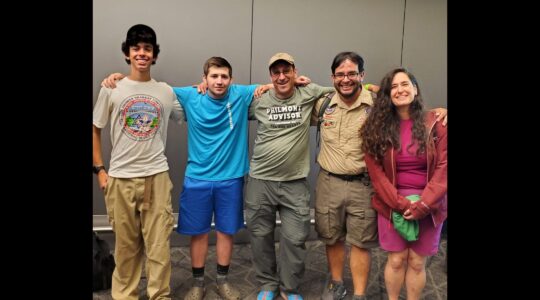SA-NUR, West Bank, Aug. 23 (JTA) — Teenage girls wept, young men were dragged out of synagogues and protesters staged a rooftop stand-off with police — but overall, the last stand against Israel’s historic withdrawal from Gaza and part of the northern West Bank ended with more of a whimper than a bang. Several thousand Israeli soldiers and police swarmed the West Bank settlements of Sa-Nur and Homesh early Tuesday morning. By late afternoon, the evacuations had been wrapped up without the violence that had been forecast. “We expected a very harsh situation here, so we prepared for it,” Sgt. Yonina Burkey of the Israeli border police said as she watched the Sa-Nur evacuation proceed. She was relieved to see the operation go more smoothly than expected. “We’re not here to fight each other,” she said, “we are here to complete a mission.” In recent weeks, residents already had left two other West Bank settlements the government ordered evacuated. In Homesh and Sa-Nur, however, officials feared that resistance would be more fierce than in Gaza because of the West Bank’s biblical significance and the numbers of hard-line settlers here. In fact, warnings that hundreds of anti-pullout foes who had flocked to Sa-Nur and Homesh could be armed and dangerous proved false. Instead, the taunts and light physical resistance that characterized the protests in Gaza were the order of the day in the West Bank as well. “You will wear this stain until the end of your lives,” one man shouted through a loudspeaker from the roof of an Ottoman-era stone building where about 30 resisters had gathered. “Are you part of the Jewish nation or merely the pawn of a Jewish prime minister who is a dictator?” another man shouted. Throughout the day, men took turns heaping insults and guilt on the security forces below. The soldiers and police quietly carried on with their work, dissembling the makeshift tent camps that had sprung up in Sa-Nur to protest the withdrawal. They used electric saws to open doors welded shut, evicting protesters who had holed up in two separate synagogues in the hilltop settlement. At a former mosque that had been turned into a synagogue and a study house used by the Chabad movement, young men pounded their fists on wooden tables and sang of the coming of the Messiah. When soldiers began to evacuate them, the group of several dozen men huddled in a corner of the building, trying to hold on to each other as they were dragged away by soldiers one by one. “Why are you doing this to me? I am your brother,” one young man shouted as he was dragged away. A senior commander overseeing the scene urged soldiers to be as gentle as possible. “Go slowly, slowly,” he said. Inside the other synagogue, worshippers were dragged out while those inside continue to pray around a Torah scroll. In the Gaza Strip, meanwhile, the army began bulldozing homes in evacuated settlements. Only when the homes are destroyed and the army bases and equipment dissembled will the Palestinian Authority take control of the area. The army announced that it expects to be completely out of Gaza by the end of September. As in Sa-Nur, there were scenes of physical resistance in Homesh. In one incident, resisters threw tomatoes, eggs and ketchup at forces climbing ladders to a yeshiva rooftop where protesters had gathered. In Sa-Nur, the main showdown came at the end of the day when riot police, hoisted in the air in metal packing containers, attempted to storm the roof of the stone building in the settlement’s center. Protesters tried to kick them away with ladders and long wooden poles. A water cannon was fired in response, dispersing the protesters immediately. The scene was captured on film by international and local media who had come to Sa-Nur in large numbers, anticipating drama. “Damned is he who expels his brother out of the house,” said a banner strung across a stone house that once served as a Turkish prison and police station. It later was used by the British army and then Jordanian forces. Most recently, the building served as an art gallery for secular immigrants from the former Soviet Union, most of them senior citizens. A young soldier watching the last of the demonstrators in Sa-Nur being taken away on Tuesday summed up the scene in two words: “Game over.”
JTA has documented Jewish history in real-time for over a century. Keep our journalism strong by joining us in supporting independent, award-winning reporting.





